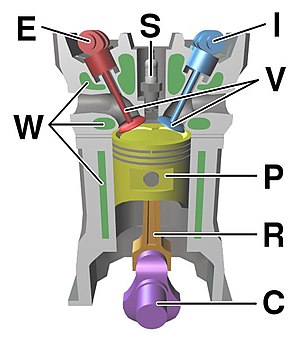Reciprocating engine

A reciprocating engine, also often known as a piston engine, is an engine that utilizes one or more pistons in order to convert pressure into a rotating motion.
The reciprocating engine was introduced with the now obsolete steam engine, but today the most common form of reciprocating engines is the internal combustion engine using the burning of gasoline, diesel fuel, oil or natural gas to provide pressure. There may be one or more pistons. Each piston is located inside a cylinder, into which a fuel and air mixture is introduced, and then ignited. The now hot gases expand, pushing the piston away. The linear movement of the piston is converted to a circular movement via a connecting rod and a crankshaft. The more cylinders a piston engine has, the more power it is capable of producing, so it is common for such engines to be classified by the number and alignment of cylinders. Single- and two-cylinder engines are common in smaller vehicles such as motorcycles; automobiles, locomotives, and ships may have a dozen cylinders or more. These engines are known collectively as internal-combustion engines, although internal-combustion engines do not necessarily contain pistons.
Though not often used today, steam or hot gasses are another power source for reciprocating engines. Steam driven ones are the steam engine. In these cases high pressure steam is used to drive the piston.
One of the most important uses of reciprocating engines that are powered by compressed air, steam or other hot gasses is the engine driving many modern torpedoes. In most cases the gas, like that produced by high test peroxide or Otto fuel II, provides the energy without need of oxygen and allows propulsion under water for considerable periods of time over significant distances. See Mark 46 torpedo.
In most applications of steam power, the piston engine has been replaced by the more efficient turbine, with pistons being used in cars owing to their requirement for a high level of torque.
See also
- Stirling engine
- Four-stroke cycle
- Two-stroke cycle
- Double overhead cam
- Diesel cycle
- Otto cycle
- Engine Balancing
For a contrasting approach to internal combustion using no pistons, see pistonless rotary engine, not to be confused with the rotary engine formerly very popular in aircraft.